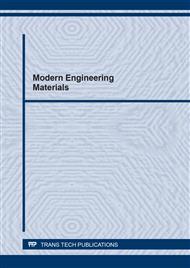p.41
p.47
p.55
p.61
p.73
p.81
p.87
p.97
p.103
Effect of Graphene Nanoplatelets on Mechanical Performance of GFRP Composites
Abstract:
The carbonaceous nanofillers such as graphene nanoplatelets (GN) due to their unique properties have been increasingly used as nanofillers to improve the mechanical properties of FRP composites. In the present study, unidirectional glass fiber reinforced polymer (GFRP) composites and GFRP composites with graphene nanoplatelets (GN-GFRP) are fabricated using vacuum bag process and hand layup method. The percentage of GN added in GN-GFRP composites is 0.1% and 0.5% in case of hand layup method and 0.5% in case of vacuum bag process. The specimens are tested under uniaxial tension and three-point bending to study the effect of GN on the tensile and flexural performance of GFRP composites. In case of composites fabricated using hand layup method, the tensile strength of GFRP composites increased by 35.8% and 40.4% with the addition of 0.1% and 0.5% GN respectively. The tensile modulus of GN-GFRP composites with 0.5% GN decreased by 11.8% compared to GFRP composites. The flexural strength of GN-GFRP composites with 0.1% and 0.5% GN are found to have increased by 6.5% and 5.3% respectively compared to GFRP composites. The flexural modulus of GN-GFRP with 0.1% GN increased by 11% and the same for GN-GFRP with 0.5% decreased by 8.2% compared to GFRP composites. The tensile strength and modulus of GN-GFRP composites fabricated using vacuum bag process decreased by 24.4% and 7.7% respectively compared to GFRP composites. Scanning Electron Microscope (SEM) investigation reveals that poor adhesion of resin with the fibers caused delamination in GN-GFRP composites fabricated using vacuum bag process resulting in reduction of tensile properties.
Info:
Periodical:
Pages:
73-80
Citation:
Online since:
April 2022
Authors:
Price:
Сopyright:
© 2022 Trans Tech Publications Ltd. All Rights Reserved
Share:
Citation:


